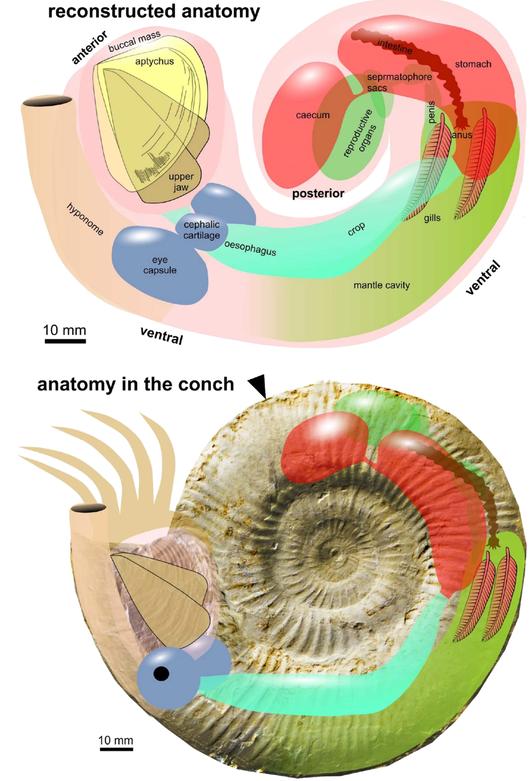The mystery of the inside-out ammonite

The spiral shells of ammonites are arguably among the best-known fossils in the world. However, remains of the animal that was housed inside the shell are exceedingly rare. “We know millions and millions of ammonites that have been preserved from their shell, so something exceptional had to happen here,” said Thomas Clements, a paleobiologist at the University of Birmingham, England. “It’s like finding … well, I don’t even know what it’s like finding, it’s that bizarre.”1
What Clements is referring to is the extraordinarily well preserved internal soft body of an ammonite located in Germany’s Solnhofen limestone deposit.2 The body was not connected to its shell. It was identified as an ammonite from its shelly lower jaw. After examination under a range of different lights, the researchers were able to identify a number of organs. This included the esophagus, stomach, intestines, central nervous system, reproductive organs, and eye capsules.
The team put forward a number of different proposals to explain how the internal body became separated from its shell. One possible explanation was that as the ammonite died the tissues connecting its soft body to the shell decayed and it fell out. But why only that tissue and not the organs themselves?


Ripped off
Another proposal was that an attacking predator ripped out the internal parts before dropping them. Some supporting evidence put forward for this was that it is missing its tentacles, which may have been bitten off. Of course, the internal body may also have become detached in the turbulent waters of the Noahic Flood if its shell was smashed against other items in the flowing waters.
Regardless of how it became detached, the much larger question is how it came to be fossilized. Examples of soft body fossilization such as this ammonite are problematic for secular long-age (‘slow and gradual’) geology. This is because soft tissue rapidly decays, or is normally quickly consumed by other sea-dwelling animals.
The remains were also coiled, maintaining the spiral structure it had when attached to its shell. This suggests it had not long been separated before it was buried. For this soft tissue to become fossilized in the limestone, it required rapid burial under a wave of lime-rich sediment. Such conditions were readily available during the Noahic Flood some 4,500 years ago. But such rapid depositions do not fit well with the story often told by evolutionists that fossils, and the rock layers around them, are a record of slow and gradual processes.
Hitting the jackpot
René Hoffmann, an ammonitologist at the Ruhr-University Bochum, Germany, referred to the ammonite as a “paleontological jackpot you have only once in a lifetime.”3 Such acclamations for this fossil make sense, given its profound clash with the expectations of secular long-age geology. Such finds are spectacular for biblical creationists, too. However, they are also wholly consistent with, and somewhat expected from, biblical history.
References and notes
- Imbler, S., This ammonite was fossilised outside its shell; nytimes.com, 31 Jan 2021. Return to text.
- Klug, C. and 3 others, Failed prey or peculiar necrolysis? Isolated ammonite soft body from the late Jurassic of Eichstatt (Germany) with complete digestive tract and reproductive organs. Swiss J Palaeontol 140 (3), 2021. Return to text.
- Ref.1. Return to text.




Readers’ comments
Comments are automatically closed 14 days after publication.